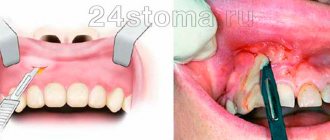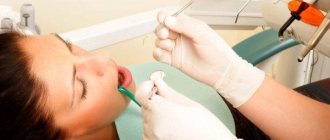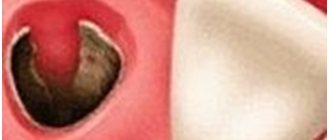Types of removal Causes of complications How long does the pain last What is the pain associated with?
Aching jaw Painful to swallow Throbbing pain How to relieve pain? Recommendations after removal Dental treatment can be therapeutic or surgical, and pain can occur after any type of intervention. If your wisdom tooth hurts after treatment, in most cases, this is a normal physiological reaction of the tissues to the procedure performed. Usually, painful sensations are quickly relieved with painkillers and go away on their own within a couple of days. But there are situations when pain after removal of the figure eight occurs due to complications or a violation of the technology of the therapeutic manipulation.
The dentist will definitely consult the patient about how the recovery process after the intervention should normally proceed, and if any symptoms appear, you should immediately consult a doctor. If all the doctor’s recommendations regarding the rehabilitation period are followed, but the painful sensations only increase, this is a direct indication to come for another appointment.
Types of deletion
Wisdom teeth (eights, third molars) are larger than other dental units in the row. They differ not only in size, but also in the complex anatomy of the root system. Eight has from 2 to 6 roots
, which are often closely intertwined with each other. Given the complex arrangement of wisdom teeth, when they are removed, a significant wound is created.
The risk of complications will directly depend on how difficult the figure eight extraction was. With simple extraction, when the tooth is intact, the roots are not intertwined, and there are no other pathologies (pulpitis, periodontitis, etc.), the risk of complications is minimal. In such a situation, the doctor uses forceps or an elevator to remove the tooth from the socket.
If the wisdom tooth is incorrectly positioned (horizontal eruption, severe curvature), intertwined roots, significant destruction of the coronal part, or the presence of inflammation, a more global surgical intervention may be required. An incision in the gum, cutting a tooth into pieces with a drill, removing root fragments through the jaw bone and other manipulations significantly increase the traumatic nature of the procedure. Aching pain, swelling after removal of the figure eight, increased temperature (up to 37.5℃), hematoma on the cheek - this is a normal reaction to the intervention, which lasts no more than 5-7 days.
Visiting the dentist if you have a cold
There is no consensus regarding the possibility of dental treatment for colds; doctors act according to the circumstances. For example, acute toothache is the basis for immediate treatment. In certain situations, the patient does not want to reschedule a visit to the doctor; clinic staff have the right to refuse to provide services in order to prevent infection of other patients.
Explanations from a qualified specialist will help you make the right decision and cancel your planned visit to the dentist. Dental treatment is accompanied by the risk of injury to the gums; wounds are a “road” for infection. In addition, painkillers can become a cause of deterioration of well-being during ARVI. A cough and runny nose are an obstacle to the dentist’s manipulations; the patient cannot stand it with his mouth open for a long time. Pauses have a negative impact on the quality of treatment; in addition, the possibility of infection of the doctor cannot be ruled out.
Why complications arise
After extraction, a wound is left in the gum and bone in which a blood clot (fibrin) forms. It “seals” the wound, preventing infection, and becomes the basis for the formation of new tissue that fills the space formed after the removal of the 8. After uncomplicated removal, healing lasts about a week. On days 3-4, the blood clot is gradually replaced by granulation tissue, which gradually fills the entire socket. Already after a month, the granulation tissue is completely replaced by connective tissue, and after 3 months - by bone.
Removal of third molars can have negative consequences that appear almost immediately after the intervention. Among the most common complications:
- “dry socket” - when a blood clot does not form or dissolves too quickly;
- paresthesia - damage to the nerve endings around the removed unit;
- alveolitis - inflammation of the socket;
- bleeding;
- cyst - fibrous formation at the site of an extracted tooth;
- endogenous periostitis (flux).
In rare cases, stomatitis, osteomyelitis, jaw trauma, and perforation of the bottom of the maxillary sinus are observed. The occurrence of complications is usually associated with ignoring the dentist’s recommendations regarding oral hygiene during the healing period, decreased immunity, and violation of surgical technique.
Simple and complex removal
How complex the operation will be directly depends on the location of the eighth molar, the correctness of its growth, the complexity of the root system and the integrity of the tooth being removed. For example, if there is severe caries damage, the doctor will have to cut it into several pieces and only then remove it.
Easy removal
Simple extraction is the extraction of a tooth using forceps, without the help of any other dental instruments. During a simple extraction, the molar is easily removed from the gums, usually without complications. Most often, figure eights of the upper jaw are removed this way, because they are clearly visible and their roots are located exactly in the gum. In rare cases, there is a problem with the removal of upper molars. Accordingly, tissue regeneration also occurs quickly. On the 3-4th day, instead of a blood clot, young connective tissue forms, after 2-3 weeks filling the entire depth of the hole. On average, bone tissue is formed after 3 months.
Complex removal – what to expect?
Complex removal is one that requires drilling out the jawbone or cutting through soft tissue. This is mainly required when extracting figure eights from the lower jaw, since the root system here is more complex. Often there is abnormal growth (impacted or dystopic tooth), in which case only complex extraction is indicated. In the area of the lower jaw, the vessels pass close to the root system and there are more nerve endings, so it is always more difficult to remove lower molars. If the doctor considers it necessary, stitches are applied after the operation.
How long pain and healing last after wisdom tooth removal depends on the following factors: the presence of an inflammatory process during the procedure, the complexity of the operation, the degree of trauma after removal, the characteristics of the body, proper hygienic care, and taking medications after surgery. A timely operation is accompanied by rapid tissue regeneration, without the need for antibiotic therapy.
Attention! A wisdom tooth hood is a soft tissue that covers an impacted tooth. This is an “extra” formation in the oral cavity, and it is very important to remove it before inflammation begins. The hood is an additional source of inflammation. If it is not excised in time, an inflammatory process may begin and antibiotics may be required.
Pain after wisdom tooth removal
Patients are always interested in the question, how many days does the jaw hurt after wisdom tooth removal? Pain after surgery is a standard tissue response to injury. Normally, the pain subsides within a few hours or within 3 days after extraction (in case of complicated removal). The pain a patient experiences after wisdom tooth removal indicates the success of the procedure.
- The first discomfort and pain appear 2-3 hours
after the intervention (when the anesthetic wears off). - The first 3-4 days
there is aching pain, redness and swelling of the soft tissues. If the extraction is successful and the hole is properly cared for, the pain will gradually disappear. - Over the next 2 weeks
, if there are no complications, the wound will heal completely, and minor pain may occasionally occur in the late afternoon. - After 3 weeks,
all discomfort should disappear.
If a wisdom tooth has been pulled out and it hurts for more than 5 days, the intensity of the pain increases, it becomes throbbing, debilitating, accompanied by fever, swelling - this indicates a complication and requires immediate medical intervention.
Complications during tooth extraction
They occur rarely and may be associated with the actions of the surgeon and the condition of the dental system:
- damage to adjacent teeth or artificial crowns. The appearance of chips, fractures, other mechanical defects, weakening, loosening is possible. More often it occurs when working with molars, access to which can be complicated, due to crowding. Requires additional treatment;
- incomplete removal. After resection, a root fragment may remain in the bone. If the area is close to a nerve or there is a higher risk of additional injury, the dentist may leave it. Doctors at the DentoSpas clinic recommend atraumatic removal to prevent such situations from arising;
- removal of a section of the alveolar ridge. If the forceps were applied to the bone tissue surrounding the tooth, it can be removed along with it. This results in a serious bone defect. To remove it, plastic surgery is performed, protective membranes and bone tissue blocks are installed;
- jaw fracture. The risk of such a complication is increased with a weak jaw bone structure. Its changes may be associated with osteoporosis and other diseases.
What could be causing the pain?
If the pain after removing the figure eight does not subside within 5-7 days, but rather intensifies, this may indicate the following complication:
- Alveolitis
is an inflammation of the socket associated with the absence of a blood clot, poor hygiene, infection of the wound, or the presence of a bone fragment in the socket (if the tooth was extracted in parts). - Severe damage to the blood vessels
of the surrounding tissues - in addition to pain, there is a hematoma, swelling of the gums and cheeks. - Allergy
to anesthetic, hemostatic sponge (if it was used during the procedure).
As inflammation develops, pain is accompanied by an unpleasant odor, purulent discharge from the socket, the formation of gray plaque, enlarged lymph nodes, increased temperature, and deterioration in general well-being. In this case, you need to see a doctor immediately.
Aching jaw
When the jaw hurts after wisdom tooth removal, it is usually due to the fact that the surgeon put pressure on it to gain access to the molar. Or during the procedure, blood vessels, nerve endings, and ligaments of adjacent dental units were injured. These symptoms are quite normal, if there is no difficulty opening the mouth, there is no pronounced swelling of the gums or soft tissues of the face.
It hurts to swallow
After extraction of the lower 8, you may experience a sore throat or pain when swallowing. This symptom appears against the background of severe damage to soft tissues, with severe swelling of the gums, cheeks, or due to trauma to the trigeminal nerve. If the trigeminal nerve was affected during the operation, there is not only pain, which can radiate to the temple, ear, neck, but numbness on the face, in the area of the removed unit, and increased salivation. Also, a sore throat may occur if there is inflammation or purulent process around the affected molar. This symptom can last up to 2 weeks. To avoid complications, you should visit a neurologist or dentist.
Throbbing pain
If your gums ache after wisdom tooth removal, but the discomfort is quickly relieved with an analgesic and disappears after 2-3 days, this is evidence of normal healing. On the contrary, throbbing pain in the jaw or gums indicates possible inflammation, damage to blood vessels and nerves. With neuritis (damage to the jaw nerves), it can radiate to the neck, throat, temple, ear, eye. The pain increases, prevents you from falling asleep, and interferes with normal life - in this case, you need to immediately consult a dentist, this is a sign of inflammation.
The relationship between ENT organs and dental health
30.10.2017
Author: Dentist-periodontist Tamara Valerievna Kudzieva
Often, patients are faced with a situation where doctors have difficulty making a diagnosis due to the proximity of certain organs, and the patient is forced to turn to related specialists in order to avoid an inaccurate diagnosis.
Dental science is no exception. The diagnosis, etiology, i.e. is quite common. The cause of which dentists sometimes find it difficult to determine. Namely, inflammation of the maxillary (maxillary) sinus - sinusitis. Or a diagnosis whose name is more familiar - sinusitis. Patients are often confused about which doctor to see, a dentist or an ENT specialist.
Let's figure out why often an ENT doctor and a dentist cannot share this diagnosis.
First, let's give a definition and understand what the maxillary sinus is:
The maxillary sinus is a cavity formation in the upper jaw, lined with mucous membrane.
The function of the maxillary sinus is to warm and purify inhaled air. When an infection penetrates, one way or another, the mucous membrane of the sinus becomes inflamed, this process is called sinusitis (sinusitis). The patient usually complains of a feeling of nasal congestion, the presence of purulent exudate (discharged fluid), headaches, fever, pain in the projection of the sinus when tilting the head and palpation.
The reasons for the development of sinusitis can be odontogenic (due to the tooth) and non-odontogenic.
Non-odontogenic causes are most often associated with complications of colds or viral diseases, rhinitis. A specialist in ENT diseases works directly with this diagnosis.
We will dwell in more detail on the odontogenic cause of sinusitis:
As noted above, the cause of the development of this type of inflammation is an infected tooth.
This is due to the anatomical features of the structure of the upper jaw, since the roots of the teeth are located close to the sinus or even directly in it:
Thus, in the presence of a chronic inflammatory process in the canals of the teeth of the upper jaw, this infection spreads to the mucous membrane of the sinus, causing its inflammation. If there is an odontogenic cause for the development of sinusitis, it is not advisable to treat only the sinus by an ENT doctor, since this treatment will not give a long-term effect. It is necessary to eliminate the cause of inflammation - an infected tooth. And often, such unpleasant manipulations as punctures, rinsing, and prescribing antibacterial agents do not bring the desired result.
And therefore, competent ENT specialists, before starting treatment, must refer the patient to a dentist to exclude an odontogenic cause for the development of sinusitis.
If the inflammation is caused by a tooth, the dentist first needs to assess the feasibility of treating and preserving the tooth. If the prospect of treatment is assessed as favorable, then the endodontist performs high-quality root canal treatment to eliminate the infection. Before permanent filling of the canals, you may need to temporarily fill them with agents that have an antiseptic effect. And then, having seen the positive dynamics, seal the tooth hermetically. If the tooth is severely damaged, or there is no possibility of passage of the canals (sclerosis, severe curvature, root perforation, false passage, broken instrument), then such a tooth must be removed.
After eliminating the cause, after a couple of months, a control CT scan is performed to make sure that the sinus has begun to recover.
It is important to note that all sinuses communicate with each other; therefore, an infection from the maxillary sinus, in the absence of proper treatment, can spread throughout the entire sinus system, which greatly complicates treatment.
Thus, a competent approach to treatment and timely redirection to a suitable specialist will prevent an incorrect diagnosis and, as a result, incorrect treatment tactics. And therefore, save the patient’s time and finances.
How to relieve pain and discomfort
- Do not touch the blood clot in the socket with your tongue, toothbrush, hands or foreign objects;
- make oral baths from herbal decoctions and antiseptic solutions;
- if the pain radiates to the ear or another part of the head, take a painkiller;
- exclude hot food and drinks.
If your gums hurt for several days after wisdom tooth removal or you have a headache, you don’t need to worry too much. Analgesics prescribed by your dentist will help you cope with these symptoms. If the discomfort does not go away after a week, painkillers do not help much - you need to go to the doctor. If the temperature is above 37.5℃, which does not decrease to normal, the development of an allergic reaction (to an analgesic, hemostatic sponge), or a sharp deterioration in health, you should consult a doctor immediately.
Limited osteomyelitis of the tooth socket
Inflammation of the bone tissue in the area of the extracted tooth :
- in the socket of the extracted tooth , and pain occurs in the adjacent teeth;
- Weakness, severe headache;
- Body temperature is 37.6-37.8°C and above, sometimes there is chills;
- Loss of sleep and performance;
- The bottom and walls of the hole are covered with a dirty gray mass with a fetid odor;
- Touching the gum is sharply painful;
- When you tap adjacent teeth, pain occurs;
- The perimandibular soft tissues are swollen, the submandibular lymph nodes are enlarged, dense, painful;
The symptoms of acute inflammation last 6-8 days, sometimes 10 days, then they decrease, the process passes into the subacute and then into the chronic stage.
- The pain becomes dull and weak;
- General condition improves;
- Body temperature normalizes;
- After 12-15 days, the tooth socket is filled with loose, sometimes protruding pathological granulation tissue, which, when pressed, releases pus.
Please note that pain relief during a complication does not mean that the process has begun to heal; perhaps it has entered a chronic, more dangerous stage. As a rule, the surgeon schedules a follow-up examination for the patient after removal; ATTENDANCE IS MANDATORY!
Symptoms of inflammation in the mouth
Inflammation of the oral mucosa involves not only its superficial layers, but also often the gums and periodontium. The latter is the ligamentous apparatus of the tooth and holds it in the bone. When these structures are damaged, the following complaints and symptoms arise: pain and redness, bleeding, swelling, the appearance of periodontal pockets, and an unpleasant odor. As the process progresses, suppuration and mobility of supporting teeth and enlargement of regional lymph nodes may appear. All of the above symptoms require specialist intervention, elimination of the cause and treatment.
Why does my gum hurt?
Unexpressed aching pain and slight swelling of the gums appear due to injuries to soft tissues, nerves, and jaw bone when removing a tooth from its bed. The gum tissue swells, the nerve endings are compressed, hence the pain. How much your gums hurt after tooth extraction depends on:
- Patient's pain sensitivity;
- degree of complexity of the intervention;
- features of the clinical case;
- location of the dental unit (after extraction of molars, the injury is greater, the pain lasts longer);
- state of immunity.
The body’s normal response from the development of complications is distinguished by the following properties: the pain does not intensify, pathological symptoms are present for no more than 7 days, and no other signs of deterioration in well-being are observed.











